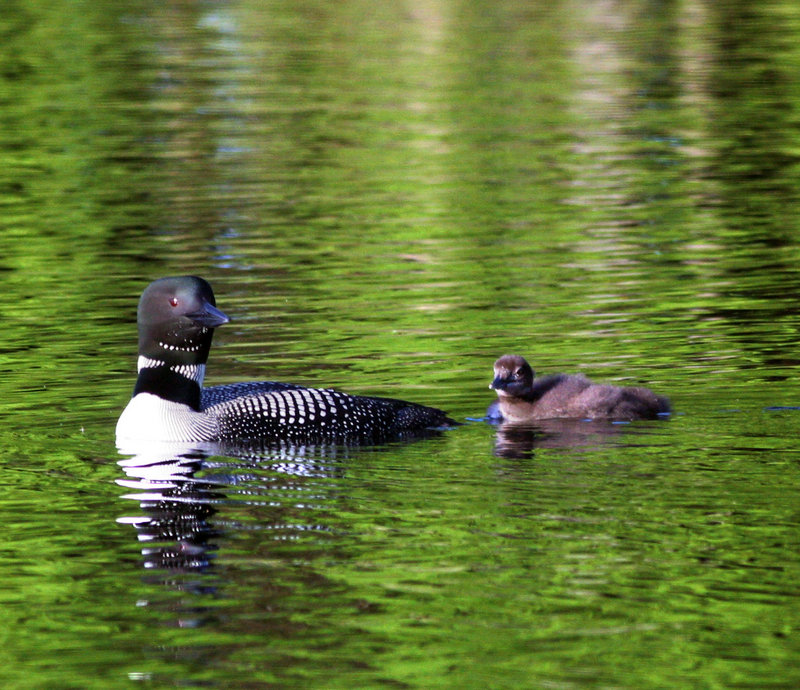The spectacle of migration is well under way. Warblers, vireos and thrushes are streaming south in good numbers now through Maine. The sparrow migration will pick up speed in October.
Migration, even for short distances, is an arduous task that demands a high expenditure of energy. Two other events in a bird’s life demand equally high energy costs: reproduction and molting. The costs of each activity are so high that no bird can do two of them at once.
There are about 10,000 species of birds in the world, so exceptions always arise when one tries to make universally true comments about some aspects of birds. That is certainly true of molting; one size does not fit all.
Nevertheless, we can make some general observations on molting and then look at some of the interesting variations on the theme.
Generally, birds undergo one complete molt every year. During that molt, every contour feather on the bird’s body is replaced. For a bird like a song sparrow, that entails replacing about 2,000 feathers. A tundra swan will have to replace more than 25,000 feathers. No wonder molting is so expensive.
The usual pattern is for the complete molt after nesting has been completed but before any migration is begun. The bird then enters its basic plumage (sometimes called winter plumage or nonbreeding plumage).
This sequence of nesting to molting to migration has obvious advantages.
After the breeding season, food is generally abundant enough to allow a post-breeding bird to find enough energy to fuel its molt. Then it is ready to migrate on fresh, efficient flight feathers.
A typical bird will have a second, partial molt near the end of the winter. Some of the body feathers will be replaced, transforming for example a drab, greenish male American goldfinch into a stunning yellow bird. However, the flight feathers on the wing and tail are generally not replaced. So, the northward migration must be done on worn feathers.
Some birds do undergo two complete molts a year. Extremely long-distance migrants and species that live in abrasive habits (thorn scrub or coarse grass) replace all their feathers twice a year. In Europe, the short-toed lark only has one complete molt per year in the summer, but an Asian race of this species that lives in sand-blown deserts has a second molt in the spring.
Molting can improve a bird’s physiological condition. The saltmarsh sparrow undergoes two complete molts each year. Seaside sparrows, nesting in the same marshes, have a complete molt in the fall and a partial molt in the spring. And seaside sparrows have more bird lice than co-occurring saltmarsh sparrows.
It’s easy to see evidence of molting in the flight feathers, which usually are replaced in a sequence so that only a few feathers are missing at any time. The innermost primary feathers and the outermost secondary feathers are molted first. In a molting bird in flight, you can see gaps or shorter feathers showing the current stage of wing molt.
Geese, swans and ducks as well as loons opt for the fast track during their flight feather molt. All of the primary feathers are shed at once. Until the feathers regrow, these birds are flightless. The birds find sheltered wetlands with enough food to allow them to hide and feed as their primaries grow.
To get to such a favorable habitat, many waterfowl stage a molt migration. After the breeding season, lakes with lots of vegetation may be populated with thousands of flightless waterfowl that flew there for the express purpose of molting.
Canvasbacks that nest in the northern United States stage a molt migration north to the Prairie Provinces of Canada after breeding. After their molt, the canvasbacks then migrate south for the winter.
Anna’s hummingbirds have a molt migration as well. These birds nest in the chaparral of coastal California in the spring, move to the high mountains for summer to take advantage of the abundant nectar where they molt, and then migrate to Arizona or Mexico for the winter.
In 1983, the American Ornithologists’ Union Check-list Committee lumped the Baltimore oriole and Bullock’s oriole into a single species, the Northern oriole, because these two forms hybridize where they overlap in the Great Plains.
These forms have now been re-split into two species. Part of this decision stems from the finding that Bullock’s orioles stage a fall molt migration to the southwestern United States and northern Mexico before molting and then continuing their fall migration. Baltimore orioles, even in the same habitat, molt before beginning their fall migration.
Herb Wilson teaches ornithology and other biology courses at Colby College. He welcomes comments and questions at:
whwilson@colby.edu
Copy the Story Link
Send questions/comments to the editors.



Success. Please wait for the page to reload. If the page does not reload within 5 seconds, please refresh the page.
Enter your email and password to access comments.
Hi, to comment on stories you must . This profile is in addition to your subscription and website login.
Already have a commenting profile? .
Invalid username/password.
Please check your email to confirm and complete your registration.
Only subscribers are eligible to post comments. Please subscribe or login first for digital access. Here’s why.
Use the form below to reset your password. When you've submitted your account email, we will send an email with a reset code.